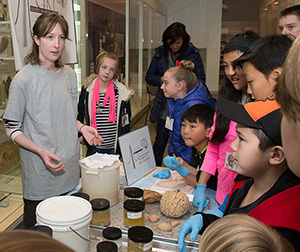Brain Awareness Week provides students immeasurable hands-on education
By Paul Bello, National Museum of Health and Medicine
SILVER SPRING, Md. - Middle school students from the greater Washington, D.C. area rolled up their sleeves and took part in numerous hands-on activities related to Brain Awareness Week (BAW), held March 16-20 at the National Museum of Health and Medicine (NMHM) in Silver Spring, Md.
The week-long classroom saw students learn first-hand from subject matter experts about such topics as the function of brain neurons, the four lobes of the human brain, the effects of drugs or alcohol on an individual's neurotransmitters and how the brain and spinal cord work together to control emotions and physical well-being.
Students also lauded being able to hold an actual brain specimen, wear goggles that simulate impaired vision or feel the electrical activity generated by muscles in their own arms and fingers.
"I definitely learned a lot about how the brain functions," said Teddy Mastal, a 7th grade student from Blessed Sacrament in Washington, D.C. "The brain is pretty complex. It has several parts that have key roles in what we do."
Maggie Finnegan, a classmate of Mastal's, particularly appreciated learning about brain safety the day her class visited.
"You hear about concussions a lot, especially when you play sports. I think it's important to know how to protect yourself from getting hurt," Finnegan said. "The more you know the better prepared you'll be."
BAW at NMHM is one of the museum's core efforts to support Department of Defense STEM (science, technology, engineering and math) workforce development priorities. The BAW program is also closely aligned with performance expectations for middle school students as described in the Next Generation Science Standards promulgated by the National Academy of Sciences.
Donna Kimbark, program manager with the Congressionally Directed Medical Research Programs, was a presenter on day one of BAW. Along with her colleague, Holly Campbell-Rosen, they demonstrated the effects of stress on the brain and how to identify stressors in students' lives.
"Stress can have an adverse effect on brain neurons," Kimbark said. "Our goal is to make young students aware of how relieving stress can increase their serotonin, which can also be found in the central nervous system."
On the topic of the social brain network, students got a glimpse of social bonding and how the sense of attachment towards animals factors into one's personal health. Meg Olmert, a neuroscientist with the Warrior Canine Connection (WCC), said auditory sounds of praise has a connection to a dog's brain, which functions quite like a human brain.
Her organization offers training dogs as therapy for wounded warriors, like Jake Young, who spent 22 years of active-duty service as a Navy SEAL before retiring. He was accompanied to BAW by Annie, a five-month old golden retriever learning how to be a service dog.
"I suffered a traumatic brain injury and spent two years at Walter Reed trying to get better. Traditional therapy wasn't working for me, so I needed an alternative," Young said. "Training dogs like Annie have helped me learn how to memorize commands. My speech has greatly improved and I was also able to improve my timing. Most of all, my confidence picked up."
Not only is BAW educational, it's also an opportunity for students to become teachers. This was the case when several Howard University medical students interacted with their middle school counterparts on everything from brain synapses and the function of cranial nerves to how the brain responds to physical therapy.
"Students today are much further along than where I was at their age. They learn a lot much faster," said Kwame Tuffuor, a first-year medical student. "I got a lot of good questions about which side of the brain is more dominant and what happens when there is damage to the cranial nerve. I'm happy to introduce kids to science. It's very important and something they can excel at with hard work."
Started 20 years ago by the Dana Alliance for Brain Initiatives, a private organization dedicated to advancing brain research, BAW aims to raise awareness around the globe on the progress and benefits of neuroscience. The program has been an educational program at NMHM for the past 16 years, according to Andrea Schierkolk, NMHM public program manager.
"I love the variation of activities for our students. I really appreciate the theme of drug and alcohol abuse being introduced, as well," said Emily Rubin, a teacher with The McLean School in Potomac, Md. "This is the second year in a row that we're participating. The value of a program like this is immeasurable."
NMHM was founded as the Army Medical Museum in 1862 and moved to its new location in Silver Spring, Maryland in 2012. For more information on upcoming events, please call 301-319-3300 or visit www.medicalmuseum.mil.

|
Caption: Visit our Brain Awareness Week 2015 at NMHM Photo Gallery |



